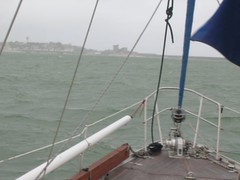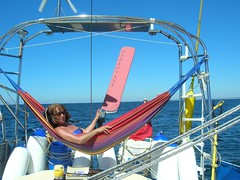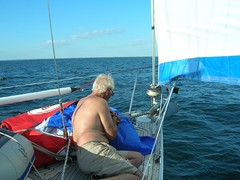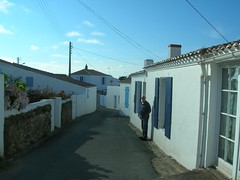 |
| Roger's second catch |
FRIDAY 3 AUGUST 2007
We left Royan Marina about 8.00 a.m. to catch the tide and we’d got a long way to go. It was a beautiful morning at first, but dark clouds had gathered before we left, threatening rain. There was a flat sea with no wind, so we motored. The clouds disappeared and by 2 p.m. it was lovely and warm. We managed to sail from about 4 p.m. and Roger fished and actually caught a good sized mackerel which we put in some water in the washing up bowl in the cockpit. Not very hygienic but it was the only thing we could grab quickly as we hadn’t expected to catch anything.
Roger then decided to fly the cruising chute, which ended up in the usual tangle. I wondered aloud who would be the first to step on the mackerel. It was Roger. The cruising chute increased our speed to 6.5 – 7.5 knots – sometimes touching 8 knots – which was too fast for me, having been in a boat which broached in the past. Roger then caught the biggest mackerel I have ever seen – it bit Roger’s finger as he took it off the hook!
The pilot book for Arcachon says to arrive about an hour either side of high water as the strength of the ebb can be up to 6 knots and there may not be enough water at low water, and the seas break over the bank. The buoys which mark the channel are moved regularly as the sand banks keep moving.
Arrival in Arcachon was rather stressful – the buoyage had been changed to match shifting sandbanks, but this meant our paper charts and chart plotter could no longer be relied on. It was against all my instincts to steer over what my charts told me were drying banks with insufficient depth for our draft. Moreover, just as we were negotiating the dangerous bar, the wind piped up to a north westerly 5 – 6, producing steep breaking waves. It was essential to find each buoy in order, which was difficult in such poor conditions.
Once over the bar, we went quite a way looking for a place to anchor. All the marked anchorages were taken up with buoys with small boats on them and looked very rolly. We eventually managed to make our way up to the Basin D’Arcachon as dusk fell and found a vacant buoy in a relatively sheltered corner. The Basin D’Arcachon is a vast area, 70% of which dries at low water. By now it was 10.00 p.m. and despite being very tired, we prepared and cooked the mackerel that we had caught earlier, which were extremely tasty. We kept the head and tails as bait for the new prawn pot which we bought in Royan.
We don’t think we like Arcachon very much – the entrance was awful, there are too many small boats on buoys and nowhere to anchor.
ROGER’S BLOG
FISHING
En route from Royan I experimented with a ‘paravane’ trolling board – a six inch long mini plastic surf board, which is trailed behind the boat on 50 metres of line with various fish lures attached. In the event of a catch, the board inverts and surfaces so that you can see there is something on the line. Although the recommended speed for trolling is under 5 knots, I was averaging 6 – 6.5 knots with the cruising chute and full main, so did not really expect to catch anything. However, wonder of wonders, the thing worked! I caught a large mackerel which would have made a decent meal for two. The second catch was even better. With some difficulty I pulled in the biggest mackerel I have ever seen! Unfortunately, this brought an abrupt halt to fishing as both Sheila and I believe that you should only take from the sea what you can eat.
MAN OVERBOARD PROCEDURES
One of the great fears for a cruising couple is the possibility of a man overboard situation. Of course, the real nightmare scenario would be if the most skilled member fell overboard leaving he weaker crew member to effect a recovery manoeuvre and, most difficult of all, hoist the casualty back on board.
Given the prospect of some 14 hours of boring motor-sailing in less than Force 2 winds on the uninspiring stretch from Royan to Arcachon, I had ample time to reflect on MOB procedures. We have two alternative methods, both requiring minimal skill and training. This last point is particularly important as Sheila is adverse to practicing recovery procedures to cope with the unfortunate possibility of me falling overboard. Indeed, Sheila’s preferred coping strategy consists of increasing my life insurance!
Method one requires no special equipment and is slightly controversial. The casualty falls in, the helmsman heaves to – assuming we are sailing – in order to stop the boat, and takes a rough bearing on the man overboard – simply sighting along the ship’s compass. Helmsman then presses the DSC distress button on the VHF radio and holds it in until the distress message is sent (i.e. 5 seconds). Controversially, we make no attempt at a spoken message. Having been involved in a real Mayday situation last year when we rescued two divers, we know how the coastguard seem to have no conception of what it is like on a lightly crewed yacht in an emergency situation and happily keep the radio operator tied up when he would be more useful on deck.
The helmsman then starts the engine, rolls up the headsail and sheets in the mainsheet hard. Given that the boat has been hove to up till now the casualty should be roughly on the same bearing as that noted earlier – both man overboard and the boat will drift with the tide at the same speed. The helm can now steer the boar back to the casualty. It does not matter whether the turn around is a tack or a gybe as we are sheeted in hard.
We depart from the RYA textbook MOB under engine manoeuvre which advocates approaching the casualty straight into wind. Instead, we position the boat between the casualty and the wind with the wind hitting the boat at 90 degrees on the beam. No attempt is made to get particularly close to the MOB - about 10 – 15 metres away is fine. Gentle forward and reverse are then used to keep the casualty in line with the shrouds and, as if by magic, the casualty appears to float in to the leeward side of the boat – actually, the boat is really drifting down on the casualty.
This method has several advantages. Minimal boat handling skill is required, the casualty is clearly visible from the helm at all times reducing the risk of running him/her over. The textbook method involves the helm losing sight of the casualty in the final stages, given a yacht with relatively high freeboard like Susannah. The pick up being on the leeward side ensures that the boat itself acts as a wave breaker, sheltering the casualty. Finally, the boat will be heeled towards the casualty, reducing the vertical distance for the casualty to get on deck.
Experienced sailors have expressed doubts about whether this method would work in strong winds, but I have tried it in various boats in all wind strengths up to Force 7. Provided the mainsail is reefed appropriately for the conditions, it works find. Indeed, a problem occurs in light winds, less than Force 1, when the boat is not blown down quickly enough on the casualty.
As regards the really difficult bit of hoisting the casualty back on board, we adopt the following procedure. The helm digs out a mooring warp from the cockpit locker, advances to the midships position where the casualty is pinned against the side of the boat, and throws a loop around the casualty. If the sea is relatively flat the casualty can now be led to the back of the boat where he/she can climb the boarding ladder – assuming a conscious casualty.
In rough conditions the stern of the boat will slam making it a dangerous place. The midships position will be the most stable and safest place for the recovery. The line around the casualty can be tied in a loop with a non-slip knot – a bowline is ideal - and then tied to a spare halyard. The helm then uses the mechanical advantage of a winch to wind the casualty out of the water and onto the deck. Sheila has successfully winched me up the mast so this recovery method should work. Indeed, on one memorable occasion, she left me stranded at the top having been distracted by a team of university male rowers who had taken advantage of a particularly fine day to shed their upper garments. At least one assumes it was only their upper garments, but given the complexity of the riding turn that she managed to produce on the winch, it could have been more!
However, if I put on more weight following too frequent visits to wonderful French restaurants and am drenched in heavy water logged clothes Sheila could resort to the electric anchor winch and haul me up.






